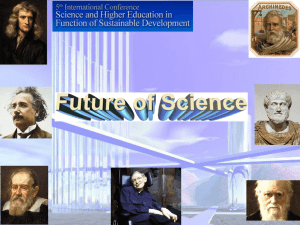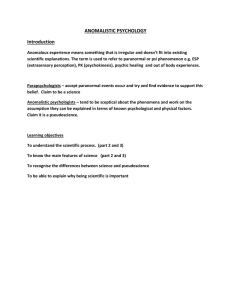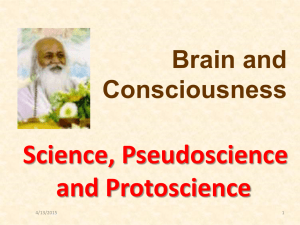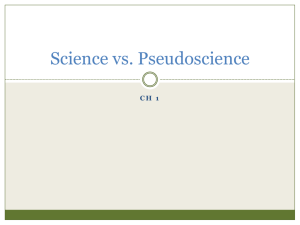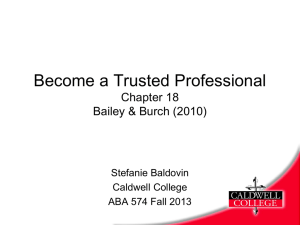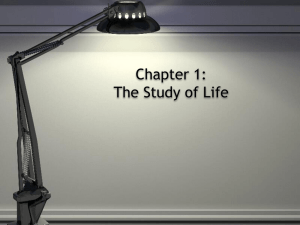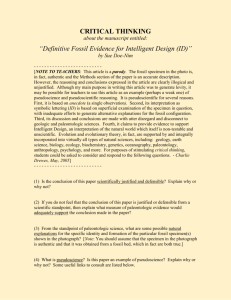Derry, G. N.
advertisement
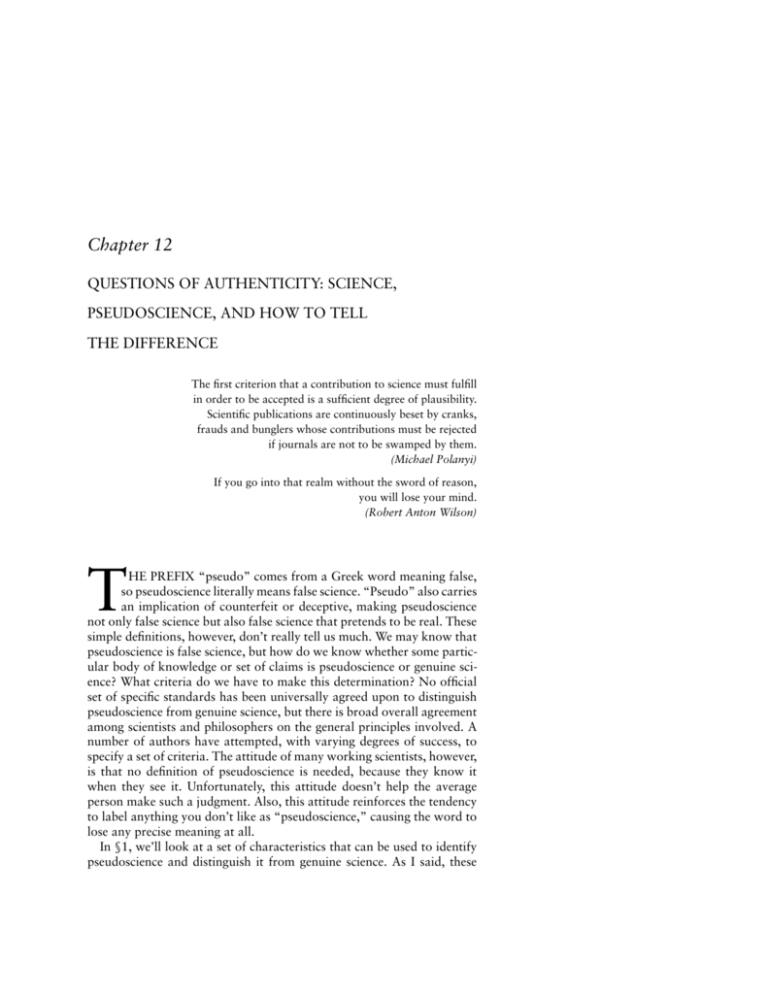
Chapter 12 QUESTIONS OF AUTHENTICITY: SCIENCE, PSEUDOSCIENCE, AND HOW TO TELL THE DIFFERENCE The first criterion that a contribution to science must fulfill in order to be accepted is a sufficient degree of plausibility. Scientific publications are continuously beset by cranks, frauds and bunglers whose contributions must be rejected if journals are not to be swamped by them. (Michael Polanyi) If you go into that realm without the sword of reason, you will lose your mind. (Robert Anton Wilson) T HE PREFIX “pseudo” comes from a Greek word meaning false, so pseudoscience literally means false science. “Pseudo” also carries an implication of counterfeit or deceptive, making pseudoscience not only false science but also false science that pretends to be real. These simple definitions, however, don’t really tell us much. We may know that pseudoscience is false science, but how do we know whether some particular body of knowledge or set of claims is pseudoscience or genuine science? What criteria do we have to make this determination? No official set of specific standards has been universally agreed upon to distinguish pseudoscience from genuine science, but there is broad overall agreement among scientists and philosophers on the general principles involved. A number of authors have attempted, with varying degrees of success, to specify a set of criteria. The attitude of many working scientists, however, is that no definition of pseudoscience is needed, because they know it when they see it. Unfortunately, this attitude doesn’t help the average person make such a judgment. Also, this attitude reinforces the tendency to label anything you don’t like as “pseudoscience,” causing the word to lose any precise meaning at all. In §1, we’ll look at a set of characteristics that can be used to identify pseudoscience and distinguish it from genuine science. As I said, these QUESTIONS OF AUTHENTICITY 159 criteria may not be universally accepted, but they are clear, sensible, and useful; I doubt whether many working scientists (or philosophers of science) will have any very serious objections to them. Following the general discussion of the defining characteristics of pseudoscience, we’ll examine several specific examples of pseudoscience in detail. In each of the examples, we’ll discuss exactly how the criteria apply to that particular case and show why it qualifies as pseudoscience (i.e., why it does not qualify as genuine science). The three examples we will look at are the work of Immanuel Velikovsky, perpetual motion machines, and creation science. §1. DEFINING CHARACTERISTICS Static or Randomly Changing Ideas One of the hallmarks of real science is growth and progress in our understanding. Ideas change over time as new discoveries are made; novel research fields open up as new techniques become available and new questions are asked; and fragmentary facts become integrated into coherent theoretical overviews as the knowledge base increases and creative minds work to comprehend this knowledge. Old ideas and knowledge are not discarded in this process; instead, they are reinterpreted in light of the new understanding that has been achieved. Many examples of this progressive growth in scientific understanding are chronicled in Part I. In contrast, the ideas in a pseudoscience either remain static or else change randomly. Either way, there’s no discernible progress. There is a good reason that we see no progress: the pseudoscience has neither an anchor in a wellestablished foundational body of knowledge, nor any systematic comparison with observation. If there is some dogmatic idea behind the pseudoscience, this idea remains static, since there is nothing to change it. If not, then ideas come and go at random because there is no particular reason to accept some and reject others. Vague Mechanisms to Acquire Understanding This brings us to our second criterion. In genuine science, the goal of the activity is to achieve some coherent understanding of our observations. We must reject our understanding if it is incoherent or if it conflicts with observations and experiments (I’m leaving out a few subtle points here; see chapter 14). In other words, there are certain general procedures that virtually all scientists would agree are valid, even if the details of how these procedures are applied may not be identical in every particular case. Most of this book is concerned with these valid procedures and how they 160 CHAPTER 12 are applied in a number of interesting examples, so I won’t elaborate here. The present chapter is concerned instead with pseudoscience, in which the procedures are only caricatures of those found in genuine science. Understanding in pseudoscience might be based on many different premises, which may be neither coherent nor consistent with observation. For example, understanding might be based on a great idea that seems to explain everything but that is so vague (and so vaguely connected to anything else) that the idea has no actual content. Or understanding might be based on connections between things that are not logical deductions or empirical findings, but rather just imagined connections in the mind of the pseudoscientist (between colors and musical scales, for example, or between sunspots and business cycles). Sometimes, two or three observations are used to prop up a vast array of speculative thought, none of which is related to or supported by any other observations. Or, to give one last example, the premises of a pseudoscience are often “proven correct” by (allegedly) proving some other premise wrong (e.g., this must be a sparrow because I’ve shown you it’s not a pigeon). This example starts to overlap with our next criterion. Loosely Connected Thoughts Rigorous logic, a strict chain of deductive reasoning with no gaps or weak spots, is highly prized in the sciences. This ideal is sometimes not possible: there are gray areas and matters of interpretation in real science; creative new work may depend on intuitions and metaphors; and, of course, scientists occasionally make mistakes. Nevertheless, the ideal of rigorous logic is still maintained as something to strive for. If a scientist makes an error of logic, the legitimate task of other scientists is to find this mistake and point it out. In pseudoscience, on the other hand, we often find wide, gaping holes in the logic; indeed, we often find that there is no logic at all, just some loosely connected thoughts. For example, a man named Ignatius Donnelly published a book in 1882 claiming that the legendary continent of Atlantis existed. He based his claims on the similarities between the ancient cultures of Egypt and South America (pyramid building, flood myths, embalming, etc.). His argument was that these similarities could only be explained by the existence of an earlier Atlantean culture, situated geographically between these two areas, which colonized them both. In this fairly simple case, the low quality of the logic is apparent. Unfortunately, promoters of pseudoscience often use technical-sounding words and scientific jargon, making it more difficult (though not impossible) for people without scientific backgrounds to spot the lack of meaning in the way words are used. We’ll see several examples of both obvious and not-so-obvious logical flaws in the case studies. A point to emphasize QUESTIONS OF AUTHENTICITY 161 is that when logical errors do occur in science, there is a way to correct them built into the normal process of doing science; in pseudoscience, such correction processes don’t exist. Lack of Organized Skepticism This last point brings us to our fourth criterion: organized skepticism. A new idea or result in science is usually presumed wrong until it is shown to be right. The typical way to present results to the scientific community is to publish the results in a professional journal. But before it can be published, new work must undergo peer review, which means that it’s sent to other scientists for criticism and judgment; only work judged as worthwhile will be published (see chapter 10). The norm in science is to subject ideas, experiments, and interpretations to criticism in order to weed out bogus results. The results that survive this process become a well-established consensus, and new results that contradict this consensus are greeted by particularly severe skepticism. On the other hand, even the consensus remains subject to criticism, and that criticism becomes severe if new and contradictory results (having survived their own skeptical scrutiny) start to accumulate. Oddly enough, skepticism keeps open the possibility of change even as it tends at the same time to foster conservatism in science. No such tradition of organized skepticism is found in pseudosciences. For those pseudosciences that are based on a preconceived belief, skepticism is in fact forbidden. For some promoters of pseudoscience, selective skepticism of other bodies of knowledge (including mainstream science) is practiced, but not of their own. For many of the believers of various pseudosciences, though, skepticism is merely an irrelevant concept. They simply don’t engage routinely in any practice of critical thinking. Needless to say, the skepticism with which scientists greet pseudoscience is generally unwelcome. This skepticism is interpreted as the close-minded response of someone invested in protecting an orthodox status quo. People who make this interpretation don’t realize the important role of skepticism in scientific thought. Disregard of Established Results Our last criterion is not only misunderstood by promoters of pseudoscience, its importance is also underestimated by many people who evaluate the competing claims of a science and a pseudoscience. Scientific advance virtually always builds on previous work (as Newton phrased it, he “stood on the shoulders of giants”). We see this time after time in the stories of discovery related in Part I. Even revolutionary changes arise out 162 CHAPTER 12 of a well-understood context, and such changes always account for the tenets of the outmoded viewpoint. Well-established results have become so through a long hard process of critical scrutiny, and these results remain established because they continue to explain a wide variety of observations and experiments in a coherent and satisfying manner. For all of these reasons, scientists work from a sturdy foundation of accepted ideas even as they try to extend our knowledge into new and unfamiliar areas. In pseudoscience, on the other hand, we find a rather cavalier disregard for established results. Indeed, contradicting known results is often taken to be a great virtue because it shows how new and exciting the ideas are. Rejecting the ideas of a pseudoscience because they conflict with everything else we know is considered (by the believers in the pseudoscience) to be close-minded and authoritarian. While I agree that any idea, no matter how unorthodox, initially deserves an open-minded hearing, this does not imply that the unorthodox idea and the established idea should be considered on an equal footing. For the reasons I’ve outlined, the unorthodox idea must be subjected to a much greater burden of proof. Those who engage in pseudoscience don’t accept the obligation to provide such proof, or even to take into consideration the foundational knowledge that has been developed by the sciences over hundreds of years. Perhaps one reason that people who work in a pseudoscience feel free to ignore established results is that such people mostly work in isolation from any broader intellectual community. Whereas a scientist works to integrate results into a larger framework (which ultimately includes all of the sciences), the pseudoscientist works alone (or in a self-contained group that maintains no intellectual contact with anyone outside the pseudoscience). This isolation is actually yet another criterion by which to identify pseudoscience. Some Afterthoughts Not every activity that meets some or all of these criteria is necessarily a pseudoscience. Only those activities that meet the criteria and also claim to be sciences are pseudosciences. For example, loosely connected thoughts not ordered by logic are perfectly appropriate (and may be quite profound) in poetry. Ideas that remain static and unchanging over thousands of years are found, again very appropriately, in religions based on scriptures. Only a fool would call poetry and religion pseudosciences. A more subtle and interesting example is provided by alchemy, which is very often labeled as pseudoscience. As cultural historians such as Mircea Eliade and Titus Burckhardt have shown, however, traditional alchemy was a method of spiritual initiation rather than a misguided attempt to do science as we know it; in that sense, alchemy is not actually a pseudo- QUESTIONS OF AUTHENTICITY 163 science. To reiterate, a pseudoscience is an activity that claims to be a science but is not a genuine science based on the criteria listed above. Our criteria are somewhat formal, and don’t include personal characteristics that are sometimes associated with practitioners of either pseudoscience or science. For example, pseudoscientists may have a tendency to feel persecuted when their ideas are rejected, harbor a seemingly personal antipathy toward mainstream science, or have a hidden agenda (such as making money or promoting a religious doctrine). I’m mentioning these personal traits because they do sometimes occur, but they are not defining characteristics of pseudoscience, they don’t always occur, and we have only a slight interest in them here. In describing the differences between science and pseudoscience, I have also been considering science in a normative sense, a kind of idealized science. In other words, I have been describing how scientists ought to behave, not necessarily how they always do behave. Real scientists, being human, sometimes fall short of this ideal (for example, scientists have been known to cling stubbornly to an idea in the face of contradictory evidence, or uncritically jump on a bandwagon). But this truism is irrelevant. The point here is that pseudoscience doesn’t even share the normative ideals of genuine science. Lastly, note that each of the five criteria listed above has significant overlap with all of the other criteria. Although I have separated them into categories for conceptual simplicity, the criteria are really all interrelated. For example: lack of skepticism allows the presence of loosely connected thoughts to go uncriticised; the lack of mechanisms to acquire understanding stifles the ability to make progress; and so on. While isolated aspects of one or two criteria may occasionally creep into real science, activities or ideas that meet most or all of these criteria (operating together and reinforcing each other) are certainly pseudoscientific. §2. VELIKOVSKY In 1950, Immanuel Velikovsky published a book called Worlds in Collision. This book was the result of a decade’s research into the myths of many ancient cultures, and the major thesis of the book was extraordinary to say the least: cataclysmic events, found in the myths of almost every culture in the world, had their common origin in real disasters caused by collisions between the earth and other members of the solar system. The book was furiously attacked by several members of the mainstream scientific community, but those events are a story of their own, which I’ll relate at the end of the section. Our primary interest is whether this work should be considered science or pseudoscience. The first question to ask is whether Velikovsky claims that his work is science. Based on comments 164 CHAPTER 12 in the preface of the book, on explicit comparisons between his ideas and standard scientific ideas, and on numerous statements made later by Velikovsky and his supporters, there is no doubt that he claims his work is scientific. How then does the work compare to our criteria for pseudoscience? Before answering this question, let’s take a more detailed look at the content of Worlds in Collision. It’s a massive book, 400 pages long with about half a dozen citation footnotes on each page. Velikovsky quotes from legends of flood, fire, earthquake, battles between deities, and so on from many, many cultures (Hebrew, Greek, Hindu, Chinese, Egyptian, Assyrian, Mayan, Choctaw, Japanese, Babylonian, Samoan, Persian, Finnish, Eskimo, Ovaherero, etc.). Most of the book is taken up by quotations from his sources, detailing these legends and myths. The Hebrew accounts in the Old Testament of the Bible are particularly prominent. To account for the similarities in the myths of so many cultures, Velikovsky believes that some real global catastrophes must have occurred. Based on the details he has found in his historical studies, Velikovsky concludes that the following events happened: A large planet-sized object was ejected from Jupiter and became a comet. This comet passed close to Earth, causing the plagues of Egypt during Exodus, along with other disasters recorded in other places. Earth passed through the tail of the comet. This tail was composed of hydrocarbons, which rained down in the form of petroleum (rains of fire) and carbohydrates (manna from heaven). The comet left Earth, went around the sun, and came back in 52 years to temporarily stop the rotation of Earth as related in the Book of Joshua. The comet later passed near Mars, causing Mars to leave its orbit and pass near Earth a few times, causing (among other things) the destruction of Sennacherib’s Assyrian army. The collision of the comet and Mars also inspired a number of passages in the Iliad. The eventual result of this collision was that Mars entered its present orbit, and the comet became the planet Venus (in its present orbit). This highly abridged account leaves out a lot, but we have enough material now to begin a scrutiny based on our pseudoscience criteria. The first thing that you may notice in this scenario is the total disregard for classical mechanics, which was exceedingly well established and had been for some time (see chapter 4). For example, the amount of energy needed to eject Venus from Jupiter is impossibly high; it’s virtually impossible for Mars to have turned the elliptical orbit of Venus/comet into the almost circular orbit of Venus; conservation of momentum is violated by some of these actions; and so on. Velikovsky claims that his work only contradicts the assumption that gravity is the sole force involved, and that electric and magnetic forces between planets can fix the situation. But he offers no theory or calculations to justify this assertion, and in fact calculations QUESTIONS OF AUTHENTICITY 165 show that such forces (which are also well understood) cannot fix the situation either. In his book, Velikovsky claims that his ideas are merely an unorthodox alternative to unproved assumptions about the stability of the solar system, a claim that many readers accepted. But his work actually contradicts a great deal of science that we are very confident is correct. Velikovsky’s bland refusal to worry about these contradictions is a sign of pseudoscience. Now, contradicting established results doesn’t by itself make his work wrong, but this does increase the burden of proof to show that the work is right. How does his work measure up to this increased burden of proof? This is an interesting question, because the book certainly offers a large amount of evidence. Page after page of quotations from culture after culture are given on each topic (example: east becoming west and west becoming east). From all this, Velikovsky concludes that some physical event happened (example: the direction of Earth’s rotation changed). The cumulative effect of all these similar legends is indeed impressive. But the evidence is not critically examined. The reliability and authenticity of the sources isn’t assessed. We don’t know what date each of the sources refers to (they would all have to refer to the same date if they described a real event). We don’t know the contexts of the quotes. And no alternative explanations are considered by Velikovsky. There is, in short, a lack of skeptical scrutiny in the work, making the evidence appear better than it really is. This lack of skepticism is another one of our criteria for pseudoscience. The book is also based almost entirely on loosely connected ideas as opposed to logical deductions. For example, a mythical description of a battle between Ares and Pallas Athena becomes a physical collision between Mars and Venus. The thunderbolts of Zeus become electrical discharges between planets. The hypothetical hydrocarbons in a comet’s tail can become either oil or food, depending on the legend being discussed. In mythology, Athena sprang from the head of Zeus; so the planet Venus was ejected from Jupiter. A local myth is first assumed to refer to a real event; the event is then assumed to be a global catastrophe; the global catastrophe is then assumed to have a cosmic origin; the cosmic origin is then assumed to be a particular planet passing by; the planet is then assumed to have some particular complicated history. Despite the length of the book and its wealth of detail, there are never any carefully constructed logical connections made between any of the assumptions in this long chain. Instead, the same assumptions are simply repeated over and over. The evidence upon which Velikovsky bases his conclusions consists almost entirely of myths, legends, and ancient writings, not observations of nature. (A few pages are devoted to geophysical evidence that couldn’t be interpreted at the time, contributing little to his work.) Yet, we are asked 166 CHAPTER 12 to base our understanding of nature (the solar system) on this evidence. This is another sign of pseudoscience (namely, our criterion of vague methods to acquire understanding). Velikovsky’s supporters may think this criticism is unfair because he did make several observational predictions (some of them correct). These predictions have been used by many people to argue that Velikovsky was right. Here are some of his predictions: Venus and Mars should be hot, due to collisions, electrical discharges, going near the sun, and so on; Venus should have hydrocarbons in its atmosphere; and Mars should have argon and neon as major components of its atmosphere. Do these predictions blunt the charge that Velikovsky’s work is pseudoscience? Venus was eventually discovered to be much hotter than expected by mainstream science in 1950. This discovery has been promoted as a striking confirmation of Velikovsky’s work, which is in turn a reason to take his ideas seriously. But this prediction is not part of a coherent picture based on Velikovsky’s ideas, because heat generated by events thousands of years ago (which his model requires) would have long since radiated away, leaving cold planets. In contrast, the scientific research that discovered the high temperature of Venus also discovered that Venus has a lot of carbon dioxide in its atmosphere, leading to a large amount of greenhouse warming (see chapter 10). This greenhouse effect (which had actually been suggested speculatively by one scientist even before 1950) accounts (quantitatively) extremely well for the temperature of Venus. But even if we didn’t have a good explanation for a hot Venus, we cannot conclude that Velikovsky is right, because his prediction was based on erroneous logic. Also, his predictions about the temperature and atmosphere of Mars are wrong (a fact usually left unmentioned by his supporters). His prediction of hydrocarbon clouds on Venus was thought to be correct for a while, and highly touted as another striking confirmation. Later work has shown that the clouds are actually made of sulfuric acid. Again, the interesting point is not so much that this prediction is wrong. Even if the prediction were right, the proper conclusion (given the fact that there was no valid logic supporting the prediction) would not be that Velikovsky’s ideas are correct. We would merely have a remarkable coincidence. We’ve seen so far that Velikovsky’s work should be classified as pseudoscience based on several of our criteria: disregard of established results, loosely connected ideas, lack of skeptical scrutiny, and vague methods to acquire understanding. Our other criterion was lack of progress and growth. His work qualifies as pseudoscience based on this criterion also, since his ideas cannot be modified based on testing, or suggest new research directions. Instead, we are given a storyline, which we can either accept or reject. Velikovsky was an interesting and imaginative thinker, and he was a patient, thorough collector of ancient QUESTIONS OF AUTHENTICITY 167 myths and legends. But his work, whatever other virtues it may possess, is not science. The controversy between Velikovsky and mainstream science is an interesting story itself. A number of scientists, particularly astronomers, were livid with rage that Worlds in Collision had been published. They attacked the work in public (reviews, letters to the editor, etc.), and they threatened the publisher with a boycott of its textbooks unless it stopped publishing the book. This censorship, combined with the abusive and disdainful treatment of Velikovsky and his work, has become an issue of its own, separate from the merits or flaws of the book. The behavior of the scientists was not well received in many quarters, being interpreted as an illegitimate attempt to suppress new and rival ideas. By making Velikovsky into a martyr, the scientists probably increased his support in the general public (presumably the opposite of what they wanted to do) and hardened the position of his followers. The inappropriate behavior of Velikovsky’s detractors, however, doesn’t improve the argument of his book. We don’t need to censor pseudoscience; we just need to learn how to recognize it. §3. PERPETUAL MOTION A perpetual motion machine is just what it sounds like: a machine that runs forever. More particularly, it’s a machine that runs forever without any fuel or source of energy to keep it going. A perpetual motion machine can continue to do useful work for us without needing any supply of gasoline, coal, electricity, and so forth. We get something for nothing. It sounds too good to be true. In fact, it is too good to be true. Perpetual motion machines do not and cannot exist. The impossibility of perpetual motion was already a current idea among the ancient Greek philosophers. Practical folks had also figured out long ago that there are no perpetual motion machines, probably based on the innumerable failed attempts to build one. Simon Stevin, back in 1586, used the nonexistence of perpetual motion as the starting point of his derivation for vector resolution of forces (in other words, Stevin felt he could take it for granted that perpetual motion was absurd). Scientific understanding of the reason why perpetual motion is impossible came later, when the conservation of energy principle was formulated in the nineteenth century. Conservation of energy is now one of the bedrock foundational principles of the sciences (see chapter 17). Attempts to invent a perpetual motion machine have a long and fascinating history. A typical design might be, for example, a water wheel that runs a pump; the pump delivers the water to a higher elevation; the water 168 CHAPTER 12 runs down, turning the water wheel; and so it goes, forever. Another popular idea uses flywheels with hinged weights on them that are supposed to use gravity to keep the flywheel turning. Many such clever mechanical contraptions and ideas have been proposed, but none of them have ever been known to work. Of course, we wouldn’t expect any of them to work based on our present scientific understanding. The U. S. Patent Office does not accept applications for perpetual motion machines anymore; the Paris Academy of Sciences refused to consider claims of perpetual motion back in 1775. But people are still claiming, even now, to have invented perpetual motion machines. Moreover, their claims are taken seriously by journalists, politicians, and investors. How can this be? Are all these people unaware of the history of failure in such attempts, and unaware of fundamental scientific results? They are in fact aware of these things, but are not concerned by them. The inventors believe they have discovered important new scientific principles that can make perpetual motion a reality for the first time in history. What is this new science that has been discovered (so they claim) by the perpetual motion machine inventors? Basically, they are saying that their machine can tap into a vast reservoir of energy that is always present but unnoticed. No violation of the energy conservation principle is involved because a source exists for the energy produced by their machines. Now, one of the modern theories of physics (quantum field theory) does in fact have such a large energy reservoir as one of its concepts (called zero point energy or vacuum fluctuation energy). Invoking such a concept makes their claims sound fairly plausible. Is the idea that we can tap into the vacuum energy to make a perpetual motion machine science or pseudoscience? The issue has now become subtle for the following reason: One of our criteria for pseudoscience is the disregard of established results. At first, we might say this criterion is obviously met, since perpetual motion is utterly forbidden by conservation of energy. But by using the concept of the vacuum energy, the promoters of perpetual motion can claim that conservation of energy is not violated; we are not creating energy out of nothing, we are simply using some existing energy. Since the vacuum energy qualifies as an established result, our conclusion seems less obvious now. However, we are ignoring a key point: the same theory that tells us the vacuum energy exists also tells us that we can’t use it. Taking this point into account, we see that the reasoning of the perpetual motion promoters does indeed disregard established results. Surely it’s illogical to use a concept in a way that is clearly prohibited by the very structure of the theory in which the concept arose. Another criterion is the lack of logical connections. To be science, their explanation would need to specify unambiguously the mechanism by QUESTIONS OF AUTHENTICITY 169 which their machine extracts energy from the vacuum. Instead, we get strings of technical-sounding words that don’t actually have any meaning (example: “The flow of load current does not create any anti-torque and therefore, the output power is greater than the input power used to rotate the device”). Isolated concepts, which don’t fit together in any meaningful way, are used. The perpetual motion machines are real (they believe), and so require an explanation. But the explanation is not sought by doing controlled experiments and trying to interpret the results within some constructive framework tied to the rest of science. Instead, a pseudo-explanation is created out of whole cloth, to somehow account for the very existence of the machine. Vague pictorial analogies are employed in place of logical connections between empirical observations (“I use the analogy of a tornado. A tornado concentrates a force in a small volume, a force that was always present, it’s just changed form.”). There is no attempt to predict quantitatively the output of the machine in response to varying conditions. All that we have are some scientific-sounding bits and pieces (a technological device, some fancy terminology, a quantum field theory concept), but none of it hangs together. The pieces don’t fit together into a picture. And this is why it’s not science. Another sign of pseudoscience is the lack of growth and progress in the field. Perpetual motion promoters actually use this argument against mainstream science; they claim that conventional scientists are dogmatically attached to outmoded ideas, while they themselves are enlightened prophets of progress. We’ve already discussed the validity of this argument. The real issue is whether there has been any progress in understanding the behavior of the alleged perpetual motion machines (or the science underlying this behavior). As we’ve already seen, there hasn’t been any such progress because the inventors are not even really trying to achieve any new understanding. Instead, the same pseudo-explanations are simply repeated over and over. I have not yet addressed one question, which you have undoubtedly been asking yourself. Haven’t these machines been tested? Determining whether they work, once and for all, should be fairly easy. I’ve saved this question to discuss in conjunction with another criterion of pseudoscience, organized skepticism. The inventors of these machines have apparently convinced themselves that their measurements prove they are getting out more energy than they put in. When other scientists and engineers point out the potential flaws in the measurements that might incorrectly lead to that conclusion, they are ignored. When independent professionals have tested the machines with the best possible equipment, the machines have behaved as conventional science predicts they should (i.e., no perpetual motion). The inventors remain unconvinced. Appar- 170 CHAPTER 12 ently, lack of organized skepticism also qualifies perpetual motion as a pseudoscience. Of course, the simplest test would also be the most convincing: plug the machine into itself and let it run without an external source of energy. The inventors have not done this, but they are sure they could if they wanted to. §4. CREATION SCIENCE The evolution of life on earth is one of the central organizing principles of modern biology. Evolution, however, has always been a controversial idea among some groups, including certain fundamentalist sects in the United States. The members of these sects believe that everything written in the Bible is literally true, and their dislike of evolutionary thought is based on the fact that it contradicts part of the Bible. Several decades ago, a number of fundamentalists with some scientific background joined together to invent something called creation science. The basic thesis of creation science is that the universe was created, in its present form including all known species of plants and animals, about five thousand years ago; and that this conclusion is defensible on purely scientific grounds. Because of these claims for scientific validity, we may subject creation science to the kind of critical analysis outlined in §1. Based on our criteria, is it creation science or creation pseudoscience? Let’s first clear up any misunderstandings caused by the close relationship between creation science and creationism in general. Creationism need not make any claims for scientific validity. We can legitimately postulate a divine being who created the universe in a way that makes it appear as though the universe had a long and involved history before this act of creation. This argument was in fact made in great detail in a book called Omphalos, written by Philip Gosse in 1857, in response to mounting geological evidence for a very old earth. The claim is based purely on religious faith; cannot be affected in any way (supported or denied) by observations or evidence; and has nothing whatever to do with science (see chapter 9). Whether we accept or reject creationism on other grounds is irrelevant to our present discussion of science and pseudoscience. Creation science, on the other hand, very explicitly claims that observations and evidence lend scientific credibility to the idea of special creation. We can (and I do) legitimately reject this absurd claim. Our very first criterion for pseudoscience was lack of progress or growth in our understanding. In the case of creation science, the understanding of its practitioners must remain static by definition because they assume up front that special creation occurred. Looking for evidence is an afterthought, engaged in only for the purpose of supporting their pre- QUESTIONS OF AUTHENTICITY 171 conceived conclusion. This conclusion will not change, regardless of any possible observation or argument put forth; the creation science promoters are quite candid about the static nature of their view on creation. Nothing can change their view, a stance that is totally antithetical to real science but quite characteristic of pseudoscience. Another criterion, closely related to the first one in this case, is the lack of organized skepticism. These two criteria are related here because an unchangeable preconceived idea cannot, by its very nature, be subjected to skeptical scrutiny. Skepticism implies asking yourself whether an idea is correct or not. Concluding that special creation is incorrect, however, has been forbidden under any circumstances by the believers in special creation. Of course, they have plenty of skepticism for the conclusions of mainstream biology, geology, and physics. But that’s not scientific skepticism, in the sense of doubting all premises in order to arrive at a correct picture; instead, selected pseudoskepticism is directed toward any ideas that disagree with their preconceived conclusions. Now, since scientists are genuinely skeptical, they criticize each others’ ideas. Creation science writers routinely quote scientists’ critical comments in an attempt to cast doubt on the validity of evolutionary ideas. Creation science itself is invulnerable to this tactic, for the reasons I’ve outlined. Ironically, these characteristics of real science (being open to skeptical criticism, and changing ideas) are exploited by creation science writers to attack evolutionary thought, misleading people who don’t understand what science actually is or how it works. As we’ve seen, however, these tactics are based on aspects of creation science that in fact identify it as a pseudoscience. Looking at the mechanisms used to acquire understanding in creation science, we see that yet another criterion of pseudoscience is met. In a way, no mechanisms are used at all to acquire understanding in creation science; there’s no need for them because the answers are already known ahead of time. Creation science has never even attempted to construct a positive research program by which our understanding might be increased. Instead, most of their writings are merely attacks on evolutionary thought, employing the dubious logic I mentioned in §1 (i.e., “If something is wrong with evolution, then special creation must be right.”). To the extent that creation science does have something positive to offer, it’s an attempt to reconcile our observations with the Biblical accounts (assumed to be true). If we rather broadly interpret “acquiring understanding” to include this sort of activity (“How do we understand what we see in a way that doesn’t conflict with our beliefs?”), then the mechanisms we find are vague, illogical, and ad hoc. Instead of fitting all the evidence together into a coherent picture, each piece of evidence is considered in isolation from all of the others. For each of these isolated pieces, the practitioners of creation science devise some kind of separate explana- 172 CHAPTER 12 tion. To assess the quality of these isolated explanations, we must move on to another of our criteria: loosely connected thoughts. Due to the underlying goals of creation science, its arguments don’t need to have any real validity. The arguments merely need to sound plausible when not subjected to any critical scrutiny. We are therefore not surprised to find vague statements and loosely connected ideas instead of well-thought-out logical connections. Let’s illustrate this point with an example: the creation science explanation for the fossil record found in layers of rock. The fossils (mostly of extinct creatures) certainly exist, and so creation science is obligated to give a scientific explanation of them. The creation science explanation is that the fossils are the preserved bodies of creatures who died in the Great Flood (the one written about in the Bible, in which all life perished except for that on Noah’s Ark). As a scientific explanation of the fossil record, this story has a major problem: it doesn’t account for the different types of creatures found in different layers of rock (geological strata). As we go into deeper and deeper layers, the bodies of the creatures become more primitive; only water-dwelling creatures appear below a certain level; and so on. An evolutionary picture accounts for these facts quite naturally, fitting together nicely with the geological picture of the layers as sedimentary rocks deposited over a long period of time. In other words, lower strata are older, and for that reason contain earlier creatures that are more primitive. The creation science picture (simultaneous death by flood) implies that all creatures should be mixed together in all the rocks. To account for the layering, various separate and unconvincing ad hoc explanations need to be devised. The basic idea simply doesn’t explain what is observed. Other questions that this idea doesn’t answer include the following: Why were water-dwelling creatures killed by a flood? Why aren’t there huge numbers of human remains in the fossil record? How did creatures repopulate islands (like Australia) after the flood? And so on. The point here isn’t that the creation science explanation of the fossil record is wrong; the point is that this explanation doesn’t really explain anything. We can never prove that this account is wrong (after all, the bodies might have miraculously sorted themselves). Nor can we prove that the evolutionary account is right. As we’ve emphasized, the role of science is not to provide certainty (which it can’t do; see chapter 14) but rather to provide coherence (which it sometimes does stunningly well). The promoters of creation science argue that, because neither evolution nor creation science can be proved, both are equally valid. This argument, which is central to their program, is based on a profound ignorance of what science is. Our last criterion of pseudoscience is disregard of established results. The advocates of creation science claim that their work is consistent with sciences other than evolutionary biology. Creation science was devised mainly as a tool with which to debunk evolutionary thought. For this QUESTIONS OF AUTHENTICITY 173 reason, promoters of creation science often use isolated fragments of mainstream sciences (e.g., thermodynamics), which they take out of context and apply incorrectly, as part of their efforts to attack evolution. In this way, they try to convey the impression that their ideas (as opposed to evolution) are really consistent with many established results. The impression they convey, however, is false. The assertion that the earth is only a few thousand years old flatly contradicts the results of many mainstream sciences: nuclear physics (radioactive decay dating), cosmology (microwave background), astronomy (redshift measurements), geology (plate tectonics, erosion), and so on. In its disregard for the well-established results of the mainstream sciences, creation science easily qualifies as a pseudoscience. To summarize, creation science is an endeavor that starts with a preconceived idea and distorts evidence to fit this idea. We achieve no increased understanding of our observations of the world because creation science isn’t based on those observations. The statements found in creation science are vague, isolated fragments, having no coherence and no logical connections to each other or to observational evidence. Creation science forbids its practitioners to engage in critical scrutiny of its assertions (also forbidding disagreement with the assertions). Creation science is inconsistent with important results in a variety of real sciences. In short, creation science amply satisfies every one of our criteria for a pseudoscience. FOR FURTHER READING Worlds in Collision, by Immanuel Velikovsky, Macmillan, 1950. Fads and Fallacies in the Name of Science, by Martin Gardner, Dover Publications, 1957. Scientists Confront Velikovsky, edited by Donald Goldsmith, Cornell University Press, 1977. Abusing Science, by Philip Kitcher, MIT Press, 1982. Ideas of Science, by B. Dixon and G. Holister, Basil Blackwell, 1984. In the Beginning . . . A Scientist Shows Why the Creationists Are Wrong, by Chris McGowan, Prometheus Books, 1984. “Power Structures,” by Tom Chalkley, City Paper (Baltimore), vol. 14, no. 26 (June 29, 1990), p. 8. Understanding Science, by Arthur Strahler, Prometheus Books, 1992. A Beginner’s Guide to Scientific Method, by Stephen S. Carey, Wadsworth, 1994. At the Fringes of Science, by Michael W. Friedlander, Westview Press, 1995. EPIGRAPH REFERENCES: Michael Polanyi, Knowing and Being, University of Chicago Press, 1969, p. 53. Robert Anton Wilson, Cosmic Trigger, Simon & Schuster, 1978, p. xix.
